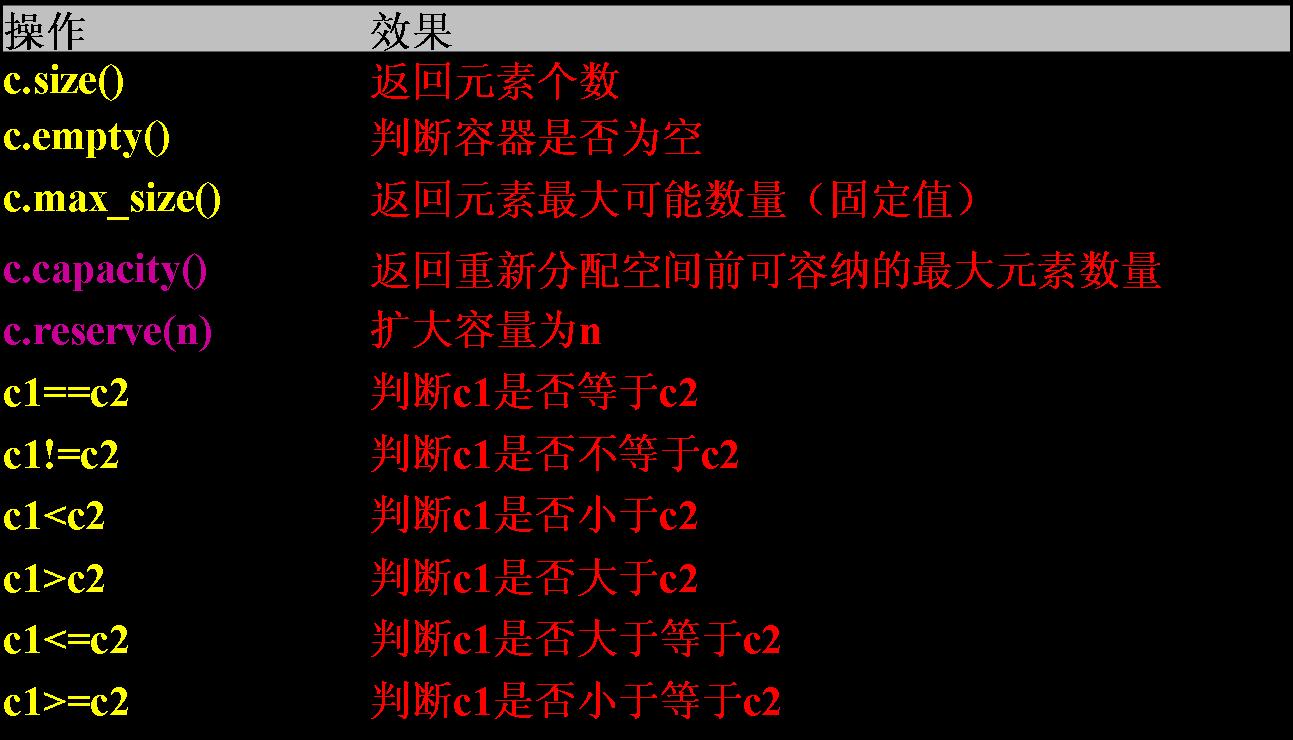vector
– 一. vector可以模拟动态数组
– 二. vector的元素可以是任意类型T,但必须具备赋值和拷贝能力(具有public
拷贝构造函数和重载的赋值操作符)
三.必须包含的头文件#include <vector>
– 四. vector支持随机存取
– 五. vector的大小(size)和容量(capacity)通常是不同的,size返回实际元素个数,
capacity返回vector能容纳的元素最大数量。如果插入元素时,元素个数超过capacity,
需要重新配置内部存储器。

->构造、拷贝和析构

->非变动操作

eg.
vector<int> v1(10); cout << "The capacity of v1 is " << v1.capacity() << endl; cout << "The size of v1 is " << v1.size() << endl; vector<int> v2; v2.reserve(20); cout << "The capacity of v2 is " << v2.capacity() << endl; cout << "The size of v2 is " << v2.size() << endl;
output :
The capacity of v1 is 10 The size of v1 is 10 The capacity of v2 is 20 The size of v2 is 0
->赋值操作

所有的赋值操作都有可能调用元素类型的默认构造函数,拷贝构造函数,赋值操作符和析构函数
如:
std::list<T> l;
std::vector<T> v;
…
v.assign(l.begin(),l.end());
eg.
vector<int> v; v.assign( 10, 42 ); for( vector<int>::size_type i = 0; i < v.size(); i++ ) { cout << v[i] << " "; } cout << endl;
OutPut :
42 42 42 42 42 42 42 42 42 42
vector<int> v1; for( int i = 0; i < 10; i++ ) { v1.push_back( i ); } vector<int> v2; v2.assign( v1.begin(), v1.end() ); for( vector<int>::size_type i = 0; i < v2.size(); i++ ) { cout << v2[i] << " "; }
cout << endl;
output :
0 1 2 3 4 5 6 7 8 9
元素存取

下面的操作是错误的:
std::vector<T> v;//empty
v[5]= t; //runtime error
std::cout << v.front(); //runtime error
eg.
vector<string> words;
string str; while( cin >> str ) words.push_back(str); sort( words.begin(), words.end() ); cout << "In alphabetical order, the first word is '" << words.front() << "'." << endl;
假设输入是: now is the time for all good men to come to the aid of their country
output:
In alphabetical order, the first word is 'aid'.
vector<int> v; for( int i = 0; i < 5; i++ ) { v.push_back(i); } cout << "The first element is " << v.front() << " and the last element is " << v.back() << endl;
output:
The first element is 0 and the last element is 4
迭代器相关函数

使用迭代器时应注意:
迭代器持续有效,除非发生以下两种情况:
1.) 或插入元素
2.) 容量变化而引起内存重新分配
eg.
vector<string> words; string str; while( cin >> str ) words.push_back(str); for( vector<string>::const_iterator iter = words.begin(); iter != words.end(); ++iter ) { cout << *iter << endl; }
假设输入是 : hey mickey you're so fine
output:
hey
mickey
you're
so
fine
插入(insert)元素

eg.
vector<char> alphaVector;
for( int i=0; i < 10; i++ ) {
alphaVector.push_back( i + 'A' );
}